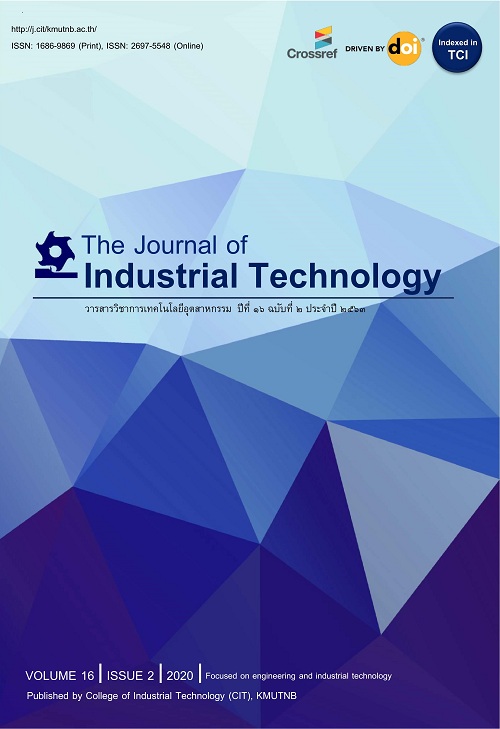การผลิตพลาสติกชีวภาพพอลิไฮดรอกซีอัลคาโนเอตจากน้ำมันปาล์ม โดยใช้เชื้อ Pseudomonas aeruginosa TISTR 1287
Production of Polyhydroxyalkanoates Bioplastic from Palm Oil using Pseudomonas aeruginosa TISTR 1287
Abstract
บทคัดย่อ
งานวิจัยนี้มีวัตถุประสงค์เพื่อศึกษาปัจจัยที่มีผลต่อการผลิตพลาสติกชีวภาพประเภทพอลิไฮดรอกซีอัลคา-โนเอต โดยใช้น้ำมันปาล์มเป็นแหล่งคาร์บอน ของ Pseudomonas aeruginosa TISTR 1287 ทำการทดลองโดยแปรผันความเข้มข้นของน้ำมันปาล์มในอาหารเลี้ยงเชื้อเริ่มต้นที่ 0.50, 0.75, 1.00, 1.50 และ 2.00 % โดยน้ำหนักต่อปริมาตร (ค่าความเป็นกรดด่าง 6.90) ทำการทดลองแบบกะในตู้บ่มเขย่า ที่อุณหภูมิ 30๐C ความเร็วรอบ 180 รอบต่อนาที จากผลการทดลองพบว่า ความเข้มข้นของน้ำมันปาล์มนั้น มีผลต่อการเจริญเติบโต และน้ำหนักเซลล์แห้งของ P. aeruginosa TISTR 1287 โดยที่ความเข้มข้น 0.75% โดยน้ำหนักต่อปริมาตร มีปริมาณน้ำหนักเซลล์แห้งสูงสุด เท่ากับ 2.33 กรัม ต่อลิตร ในชั่วโมงการหมักที่ 44 นอกจากนี้ช่วงระยะเวลาของการหมักอาหารนั้นยังมีผลต่อการผลิตและการสะสม พอลิไฮดรอกซีอัลคาโนเอตของแบคทีเรีย โดยปริมาณและผลผลิตพอลิไฮดรอกซีอัลคาโนเอตที่สกัดได้ จะเพิ่มขึ้นตามระยะเวลาของการหมักที่มากขึ้นและเพิ่มขึ้นสูงสุดที่ระยะเวลาการหมัก 72 ชั่วโมง มีปริมาณ พอลิไฮดรอกซีอัลคา-โนเอต 0.65 กรัมต่อลิตร (38.01%) เมื่อนำเซลล์แบคทีเรียไปวิเคราะห์ผ่านกล้องจุลทรรศน์ฟลูออเรสเซนต์ พบว่าเซลล์แบคทีเรียมีการเรืองแสงสีแดงของสีย้อม Nile red ได้ชัดเจน ในขณะเดียวกันก็สามารถเห็นลักษณะของพอลิไฮดรอก-ซีอัลคาโนเอตที่แบคทีเรียสะสมไว้ในรูปของเแกรนูลสีขาวอย่างชัดเจน เมื่อนำไปส่องผ่านกล้องจุลทรรศน์อิเล็กตรอนแบบส่องผ่าน จากผลการทดลอง จึงสรุปได้ว่า P. aeruginosa TISTR 1287 สามารถใช้น้ำมันปาล์มเป็นแหล่งคาร์บอนเพื่อผลิตพลาสติกชีวภาพชนิดพอลิไฮดรอกซีอัลคาโนเอตได้
Abstract
This research aimed to investigate factors affecting the production of polyhydroxyalkanoates (PHAs) from palm oil as a carbon source by Pseudomonas aeruginosa TISTR 1287. The experiments were set-up a batch in an orbital shaker incubator at 30๐C with 180 rpm. Four concentrations (0.50, 0.75, 1.00, 1.50 and 2.00 % (w/v)) of palm oil were tested and initial pH in the culture medium was fixed at 6.90. The results showed that the concentrations of palm oil have the effect on cell growth and cell dry weight of P. aeruginosa TISTR 1287. The maximum cell dry weight at 44 hrs was 2.33 g L-1 obtained from the palm oil concentration of 0.75% (w/v). Moreover, the culture time also affected the cells growth and intracellular accumulation of PHAs. The PHAs concentration and content were increased when increasing the culture time from 0 to 72 hours. The maximum PHAs concentration was 0.65 g L-1 and PHAs content was 38.01 % when cultured in medium with 0.75% (w/v) palm oil at 72 hrs fermentation. The microbial cells in the culture medium showed high red fluorescent, when the cells were determined using the fluorescent dye Nile red. The PHAs granules of intracellular the microbial cell were seen easily (white granules) by transmission electron microscope. The results demonstrated that P. aeruginosa TISTR 1287 can be used palm oil as a carbon source for producing the PHAs based bioplastics in an intracellular.
Keywords
Refbacks
- There are currently no refbacks.






